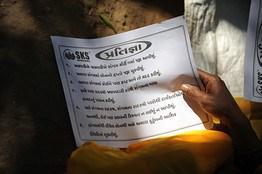
A recent Wall Street Journal article discusses the negative implications of completely ruling out the microfinance model as an important channel for delivering products and services, such as healthcare, to the poor. The article sites that in India out-of-pocket health expenditures “increase poverty by as much as 3.6% and 2.9% for rural and urban Indian, respectively.” Microfinance could serve as important platform to help entrepreneurs that are part of the informal economy, better access healthcare and understand their options through awareness campaigns, linkages to hospitals and clinics, and financing mechanisms. By Somen Saha and Marcia Metcalfe
The microfinance industry, widely accepted as a model for poverty alleviation, is suddenly subjected to intense criticism, particularly in South Asia.
SKS and others have taken heat in the southern Indian state of Andhra Pradesh for allegedly shoddy practices and high interest rates while in Bangladesh the life-long work of Nobel laureate Muhammad Yunus has been described as entrapment of the poor into greater indebtedness.
Although the debate around regulating the microfinance sector is pertinent, blaming the entire sector will not only affect the lives of millions of poor served by the industry but also impede the tremendous potential that microfinance holds for allied causes like advancing universal health coverage in India.
In 2009, the microfinance industry in India was estimated to serve 81.7 million people. Annual credit demand by the poor in the country is estimated to be about 600 billion rupees but only about 20% of the rural poor are estimated to have access to microcredit. Along with access to credit, there will be a greater reduction in poverty if microfinance programs can become a vehicle for advancing health coverage.
Out-of-pocket health expenditure increases poverty by as much as 3.6% and 2.9% for rural and urban India, respectively. Microfinance provides a promising platform to expand health access and coverage to workers in the informal economy through organized groups.
Most microfinance-assisted entrepreneurs are not part of the very poor, and are not employed in the organized sector. A portion of clients (one out of three new microfinance clients) are from urban backgrounds and reside in unauthorized colonies with limited access to basic health services.
This renders them vulnerable to poor health conditions and the financial shocks of illness. Not only can microfinance provide a platform for extending health coverage through India’s national health insurance programs but they can facilitate increased access to health services through awareness generation, create linkages with healthcare providers, and provide other financing mechanisms such as health loans or health savings plans that can support or supplement health insurance programs.
Increasingly, microcredit banks are realizing that providing some kind of health coverage in tandem with loans is essential if they want to fulfill their mission to improve lives. Some of the benefits of integrating health services and microfinance include economic empowerment, social empowerment, and reduced gender disparity.
Adding health education alone, usually delivered during the routine scheduled microfinance group meetings, improves health knowledge that leads to measureable behavioral change associated with positive health outcome in diverse areas critically important to achieving the Millennium Development Goals in areas such as maternal and child health and infectious disease.
A demonstration project in India by Freedom from Hunger, where one of the authors works, showed that out-of-pocket expenses to offer health education and product distribution by a microfinance company in West Bengal amounted to $0.17 per client per month, suggesting that microfinance firms can provide these service efficiently and at low cost with considerable value to clients.
About one quarter of Indian microfinance outfits offer some form of health services. These programs vary widely from small-scale health awareness programs to complex health interventions. However, despite islands of experiments in India to layer health protection services onto microfinance programs, only about 10% of existing microfinance clients have some access to health services.
There is some tension about whether microfinance outfits should concentrate in their core business of credit operation, or attempt to provide access to health services for clients. Questions linger like: How much does it cost to offer health services? Who will pay for access to health services? What services are best for clients’ health needs? How will the products be designed?
Often microfinance firms struggle to design appropriate community-sensitive health programs. This underscores the necessity of building an effective technical capacity in program design and implementation. Some possible strategies include:
1. Establish a platform for microfinance firms, health practitioners, researchers and policy makers to share experiences and concerns that can lead to the development of a roadmap for advancing health coverage through microfinance in India.
2. Establish research and demonstration projects to help scale up integrated health and microfinance programs in India.
3. Establish dedicated inter-disciplinary centers to promote integrated health and microfinance programs in India.
The provision of these services really does help to address concerns about the social value proposition of microfinance by improving both the financial health of the organization and its social performance. Adding health to microfinance and improving health and financial security for clients holds great potential for improving the overall health of individual microfinance firms, the industry, and its reputation in India.
–Somen Saha is senior lecturer at the Indian Institute of Public Health Gandhinagar, Gujarat. He can be reached at ssaha@iiphg.org; Marcia Metcalfe is director of microfinance and health at Freedom from Hunger. She can be reached at mmetcalfe@freedomfromhunger.org http://blogs.wsj.com/indiarealtime/2011/04/26/india-journal-linking-health-and-microfinance/
